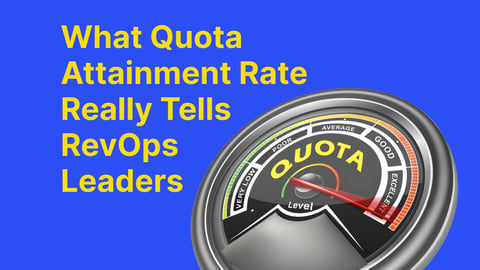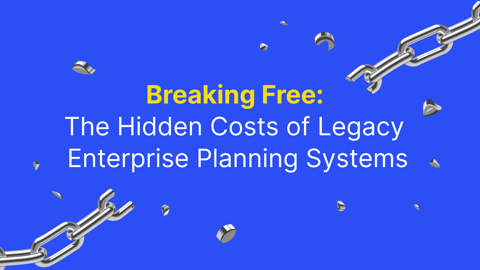As we move to the end of Q2, conversations are moving quickly from "how do we respond to COVID-19?" to "how do we accurately forecast our business when we can't rely on historical sales performance anymore?".
For many organizations, Q2 will be the first full sales quarter as a remote sales organization. If that isn’t difficult enough, budgets and businesses are locked down.
In this week’s blog, we outline some specific ways to approach rebuilding your forecast during a crisis and ongoing habits that should be built into your team practices to help you increase your win rates with efficient, methodical, and consistent improvements over time.
Now’s the time to dig deep
Don’t waste a crisis.
Start by stepping back with a critical eye to look at how you approach forecasting across the entire sales operations process. Don’t focus on one deal, one quarter, or one year. Take a bottoms up approach and break it down.
Look specifically at the way you and your team members operate and communicate throughout the sales lifecycle.
Start by asking the following questions:
- Is the meaning of forecasting understood well by your teams, from leadership, to front-line managers, to sales reps?
- Do you consistently look at both the micro level (the deal) and the macro level (the funnel) of forecasting?
- What’s in your control to realistically increase forecast accuracy?
- If you only rely on historical performance to guide forecast accuracy, are you leaving deals on the table by not monitoring deal health?
- Are you optimizing efficient growth or growth at all costs in the deals you choose to pursue?
Before we can take a look at the nitty gritty of forecasting principles while we’re up against in a crisis, let’s examine the various ideas and definitions of forecasting and how it is often interpreted and practiced throughout the sales cycle.
What we talk about when we talk about forecasting
Forecasting means different things to different team members at different stages of the sales cycle. Discrepancies in understanding and the agency to execute on that understanding can often lead to a breakdown of communication and result in unmet expectations.
The integrity of a forecast – that is, its viability and accuracy – is determined by the data, information, and consistent approach that goes into it. If your data, communications, and other inputs don’t accurately reflect what is really going on right down to the deal level, the upstream effect is misdirected forecasts and unmet numbers.
Collaborative forecasting is the result of sales organizations communicating well and consistently during multiple points in the pipeline and sales cycle.
The only way to build a viable and predictable forecast is to design it with real and consistent information from the ground up in sales operations. Visibility, accountability, and repeatable behaviours in team operations are key to the quality of information you are using.
Sales is a time-based exercise, so it’s easy to break down the discussion into time-bands.
Fundamentally, your forecast needs to answer these questions:
- When is a deal going to close?
- How much is that deal going to be worth?
- What is your confidence level that it’s going to be closed won?
These questions can scale from micro to macro across your business:
- Deal: Forecasting deals that are going to close. How much are you forecasting that deal is going to be worth? When will it close?
- Month/Quarter: The dates are locked down, so the question is easier – which deals are we going to close this month or this quarter as a group, and what are they worth?
- Long term growth: Longer term planning based on historicals and assumptions. How are we going to forecast growth?
Forecasting is often used interchangeably by different roles in the sales cycle, who have different - and yet inherently connected - short and long term goals:
- Sales Rep: Working a deal or a series of deals.
- Sales Team: What are we going to close in the funnel this month? This quarter?
- Leadership: Determines forecasts at the macro level driven by long-term revenue.
All of these micro elements feed up to the business level; it’s about how you forecast the growth of large groups of sales operations teams and individuals and move toward a common goal of capital efficient revenue growth.
Most organizations use these categories to forecast:
-
Won: You’ve already won this deal, so it contributes to the revenue goal.
-
Commit: You have a high degree of confidence and the rep commits to the deal being closed within a specific date range and deal size.
-
Best case: If everything goes according to plan.
-
Pipeline: The deal is qualified, but the exact close date and deal size are to be determined.
-
Omitted: The deal is not qualified enough yet to be in the pipeline, and the rep can’t forecast the close date or deal size.
Many organizations end up having sales leadership rely solely on categorizing elements of a forecast. This often results in a myopic view at the expense of actually understanding and interpreting what is in stages effectively. As a result, all of the truly insightful, bottoms-up metrics - age in stage, conversion rates, pipeline health by stage, or coaching opportunities - are then lost because the forecast itself becomes the goal.
Forecast integrity is data integrity
In the current economic climate, relying on historical trends and historical conversion rates isn't going to cut it. So you need to get into the details and rebuild your forecast from the bottom up.
Rebuilding your forecast to be truly holistic has to start with accurate data in the system. As they say: garbage in, garbage out.
For example, say 20% of your deals are backdated, or are won the day they're created but the rest of the deals take 8-12 months to win:
- How can you forecast when 20% of your deals aren't even in the system?
- Or what if they sit in stage 1 for a year before moving immediately to closed won because the rep didn't want executive scrutiny on their pipeline?
An accurate forecast begins with effective deal management and this begins at the rep level:
- How confident are you that reps are managing the deals effectively?
- How confident are you with each deal?
A few weeks ago we wrote about the difference between a forecast, a coverage model.
When we talk about forecast accuracy or improving the forecast, what does that really mean at an individual level and an aggregate level? What tools and methods do you need to execute?
Are your reps:
- Moving at the right clip?
- Managing the deals effectively?
- Inputting the close date accurately? Or are they changing it multiple times?
Are your deals:
- In the right stage in the system?
- Focused on the right buyers?
- The right size? (Meaning they aren’t changing in value frequently and often.)
Adapting your sales model for how reps manage and communicate changes internally are direct, impactful influences on your forecasting ability and accuracy.
Of course, all of this – forecast accuracy, deal management, remote sales management – requires strong Salesforce adoption.
Bottoms-up deal health means no deal is left on the table
If you are a sales leader and you manage the business entirely from a top down point of view, you are bound to miss some key indicators and thus, potential deals and revenue.
Instead, flip the traditional model on its head and build a bottoms up approach focused on building blocks that guide us along the way.

The key to accurate and realistic forecasting is to assess, manage, and determine as many combinations of variables as you can. The best way to get visibility into those variables is to manage your deal health system daily and consistently.
Marginal gains lead to increased more predictable revenue, which leads to long-term accuracy of forecasting.
There are no silver bullets for forecasting generally –never mind during an economic crisis – leaving us little to work with at the moment. The accuracy of the result is only as good as the data you put in and the consistency of how you monitor your deal health.
Rebuilding your forecasting strategy now to include all of your sales operations will increase long term, sustainable visibility across your business and result in more efficient and transparent sales operations which increases your win rate via marginal gains and grows your business efficiently and systematically.




